From the tranquil lakeshores to the dense northern forests, Wisconsin is a haven for a myriad of bird species. Among them, a select group of red birds stand out, painting the Badger State’s skies with vivid splashes of color.
Dive into our curated list of 12 mesmerizing red birds native to Wisconsin, and to further fuel your ornithological passion, we’re offering a complimentary photo guide.
Whether you’re a seasoned birdwatcher or just starting out, this guide will be a delightful addition to your collection.
Red Birds Found In Wisconsin
Wisconsin’s geography is a mosaic of habitats, making it a paradise for birdlife. The state’s vast freshwater systems, from the Great Lakes shores to myriad inland lakes and rivers, provide essential habitats for numerous waterfowl and shorebirds.
The northern coniferous forests are home to species adapted to cooler climates, while the southern deciduous woodlands shelter a different array of birds.
Northern Cardinal


| Feature | Measurement |
|---|---|
| Scientific Name | Cardinalis cardinalis |
| Length | 8.3 – 9.1 in |
| Wingspan | 9.8 – 12.2 in |
| Weight | 1.19 – 2.29 oz |
The Northern Cardinal is an iconic North American bird, easily recognized by its vibrant color and melodious song.
Appearance: Male Northern Cardinals are a brilliant scarlet red, while females display a more subdued reddish olive. Both sexes have a distinctive black ‘mask’ on their face around the bill and a pointed crest on their head. The bird’s beak is robust, cone-shaped, and bright orange in color.
Diet: Northern Cardinals are primarily granivorous, with a diet largely consisting of seeds and grains. They also eat fruits and insects. These birds typically feed off the ground and are frequent visitors to bird feeders.
Reproduction: Northern Cardinals are monogamous, and a pair will breed together for life. The female typically builds a well-hidden nest in a dense thicket or shrub. She lays 2-5 eggs per clutch, which she incubates for around two weeks.
Red-headed Woodpecker

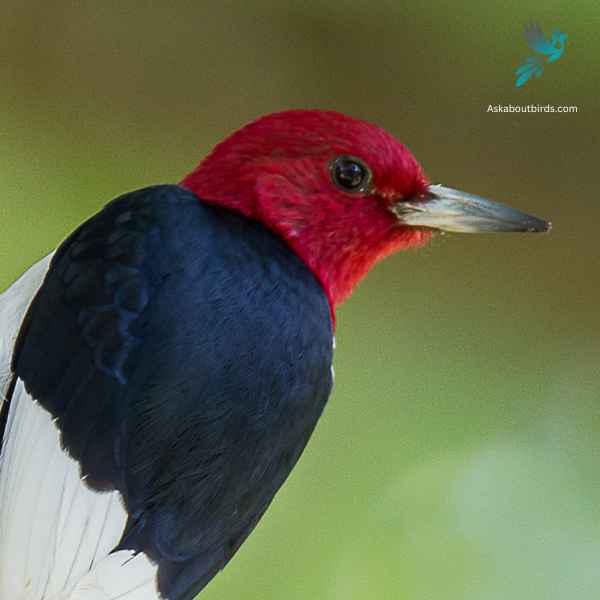
| Feature | Measurement |
|---|---|
| Scientific Name | Melanerpes erythrocephalus |
| Length | 7.5–9.1 in |
| Wingspan | 16.5 in |
| Weight | 2.0–3.2 oz |
The Red-headed Woodpecker is a striking forest bird with a bold tri-colored pattern.
Appearance: This woodpecker features a completely red head and neck, contrasting starkly with its white underparts and black wings. Its wings also have large white patches which are conspicuous in flight.
Diet: Red-headed Woodpeckers have a varied diet including insects, seeds, fruits, berries, and occasionally even the eggs of other birds. They’re also known to store food by wedging it into crevices in bark.
Reproduction: These woodpeckers nest in cavities which they excavate in dead wood or dead parts of live trees. These cavities can be found anywhere from 2 to 80 feet off the ground.
Scarlet Tanager


| Feature | Measurement |
|---|---|
| Scientific Name | Piranga olivacea |
| Length | 6.3 to 7.5 in |
| Wingspan | 9.8 to 11.8 in |
| Weight | 23.5 to 38 g |
The Scarlet Tanager is a strikingly colorful bird known for its brilliant plumage and distinctive song.
Appearance: Male Scarlet Tanagers are notable for their vibrant scarlet bodies contrasted with black wings and tail, making them one of the most intensely colored birds. Females and juveniles, on the other hand, have a subdued olive-yellow body color with darker wings and tail.
Diet: The diet of the Scarlet Tanager is largely made up of insects, including beetles, cicadas, aphids, and others. They are adept flycatchers, seizing insects in mid-air or picking them off foliage. They also consume fruits and berries, especially during migration and in their winter habitats.
Reproduction: The female Scarlet Tanager builds a cup-shaped nest using twigs, rootlets, and grass, typically well-hidden in the dense foliage of trees. She lays 3 to 5 eggs and incubates them for about two weeks.
Summer Tanager


| Feature | Measurement |
|---|---|
| Scientific Name | Piranga rubra |
| Length | 6.7 in |
| Wingspan | 28 to 30 cm |
| Weight | 29 g |
The Summer Tanager is a medium-sized songbird admired for its radiant plumage and melodious song.
Appearance: Male Summer Tanagers are an impressive bright red, while females and juveniles present a softer, yellow-orange color. Both genders have a large, slightly hooked bill and relatively short tail.
Diet: Summer Tanagers primarily feed on insects, including bees and wasps, which they catch in flight or pick off vegetation. They are also known to eat fruits and berries, making them helpful in controlling pest populations and seed dispersal.
Reproduction: The female Summer Tanager builds a loose, shallow cup-shaped nest out of twigs and grass, usually hidden in the foliage of trees. The female typically lays 3-5 eggs, which she will incubate for about two weeks.
Rose-breasted Grosbeak
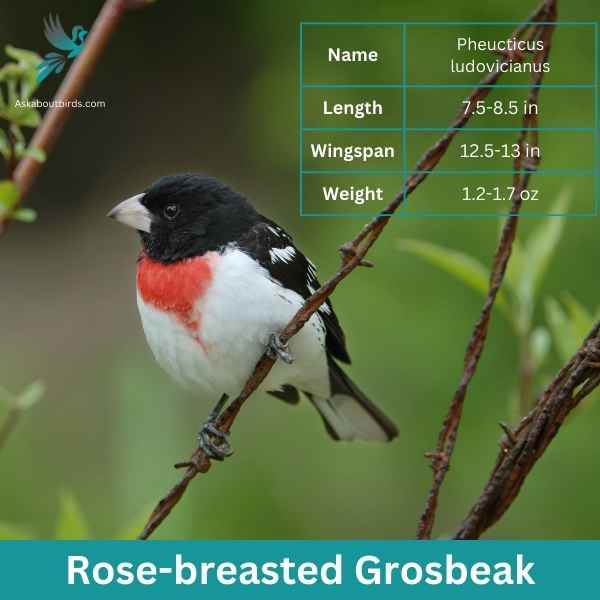

| Feature | Measurement |
|---|---|
| Scientific Name | Pheucticus ludovicianus |
| Length | 7.5-8.5 in |
| Wingspan | 12.5-13 in |
| Weight | 1.2-1.7 oz |
The Rose-breasted Grosbeak is a songbird of medium size, widely recognized for its vibrant coloration and melodious song.
Appearance: Male Rose-breasted Grosbeaks boast a striking contrast with black and white plumage accompanied by a radiant rose-colored patch on the chest and under the wings. In contrast, females exhibit streaked brown and white plumage, resembling large sparrows but with a thick bill.
Diet: The diet of the Rose-breasted Grosbeak consists of a mixture of seeds, insects, and fruits. During summer, they primarily feed on insects, while seeds and fruits become more prevalent in their diet during the colder months.
Reproduction: These birds build cup-shaped nests typically situated in trees or large shrubs. Both the male and female partake in incubation duties, ensuring the eggs’ safety and warmth. After hatching, the chicks are primarily fed insects.
Red-Winged Blackbird
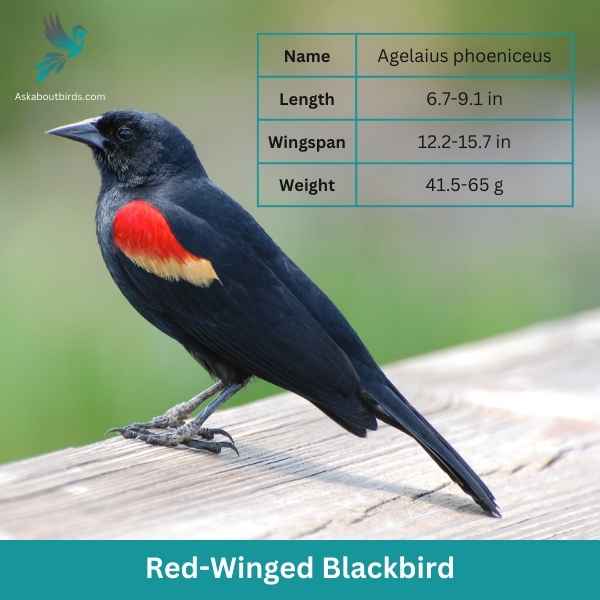
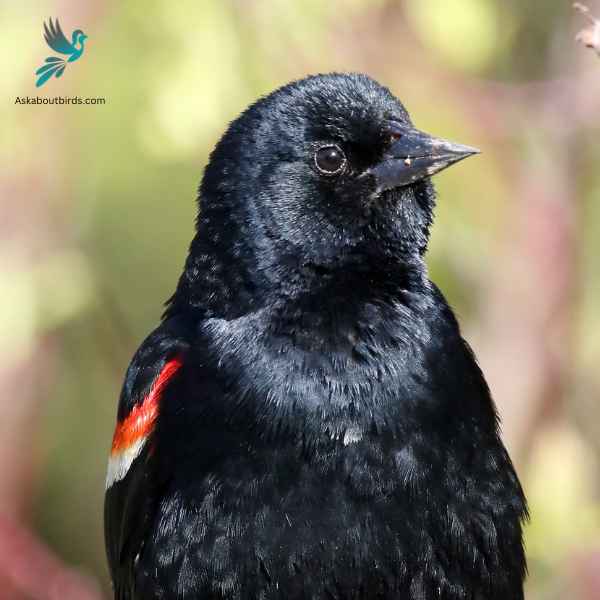
| Feature | Measurement |
|---|---|
| Scientific Name | Agelaius phoeniceus |
| Length | 6.7-9.1 in |
| Wingspan | 12.2-15.7 in |
| Weight | 41.5-65 g |
The Red-Winged Blackbird is a familiar sight across North America, especially in wetlands and open areas. Known for its striking coloration and distinct call, it is often seen perched on cattails or utility lines.
Appearance: Male Red-Winged Blackbirds are glossy black with bright red-and-yellow shoulder patches, while females are streaky brown, resembling a large sparrow. The males’ red patches become more prominent when they’re displaying or agitated.
Diet: Red-Winged Blackbirds primarily feed on seeds and insects. Their diet includes grains, sunflower seeds, and corn, but they also eat beetles, caterpillars, and other small invertebrates, especially in the breeding season.
Reproduction: Red-Winged Blackbirds nest in marshes, along watercourses, and in wet fields. The female constructs a cup-shaped nest using grass and sedge, attaching it to plants above water. She typically lays a clutch of 3 to 4 blue-green eggs, which she incubates for about 11-12 days. Males, being polygynous, often have multiple mates during a single breeding season.
Eastern Towhee

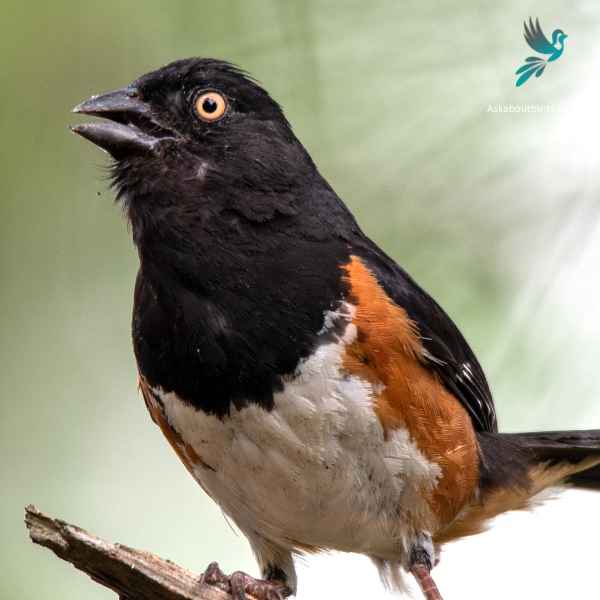
| Feature | Measurement |
|---|---|
| Scientific Name | Pipilo erythrophthalmus |
| Length | 6.8 to 9.1 in |
| Wingspan | 7.9–11.8 in |
| Weight | 32 to 53 g |
The Eastern Towhee is a distinctive songbird known for its unique calls and eye-catching coloration.
Appearance: Male Eastern Towhees are characterized by a striking combination of a black head, back and tail, contrasting with a white belly and rufous flanks. Females sport similar patterns but instead of black, they have a rich brown color. Both genders have red eyes, lending a special charm to their overall appearance.
Diet: Eastern Towhees primarily feed on a variety of insects, seeds, and berries. Their diet is quite diverse, taking advantage of seasonal offerings, which includes beetles, caterpillars, spiders, acorns, grass seeds, and various fruits and berries.
Reproduction: Eastern Towhees build their nests on or near the ground, often in a shrub or a small tree. The female lays around 3-5 eggs and takes the primary role in incubating them over about 12-13 days.
House Finch


| Feature | Measurement |
|---|---|
| Scientific Name | Haemorhous mexicanus |
| Length | 5–6 in |
| Wingspan | 8–10 in |
| Weight | 0.6–0.9 oz |
The House Finch is a small songbird widely distributed across North America and is commonly found in urban and suburban areas.
Appearance: Males of this species are brightly colored with crimson faces and throats, which can extend to the chest and back, while their flanks have streaks. The female is streaked brown and lacks the red coloring. Both have a square-tipped tail and a distinctively long, flat-topped bill.
Diet: House Finches primarily eat seeds, grains, and berries. They have a particular fondness for sunflower seeds and can be commonly seen at bird feeders. Occasionally, they will also consume insects, especially during the breeding season.
Reproduction: House Finches are cavity-nesters and might choose ledges, vents, ledges, and other urban settings. They might also utilize trees or shrubs. Their nests can be made of a wide array of materials, from feathers to twigs.
Pine Grosbeak

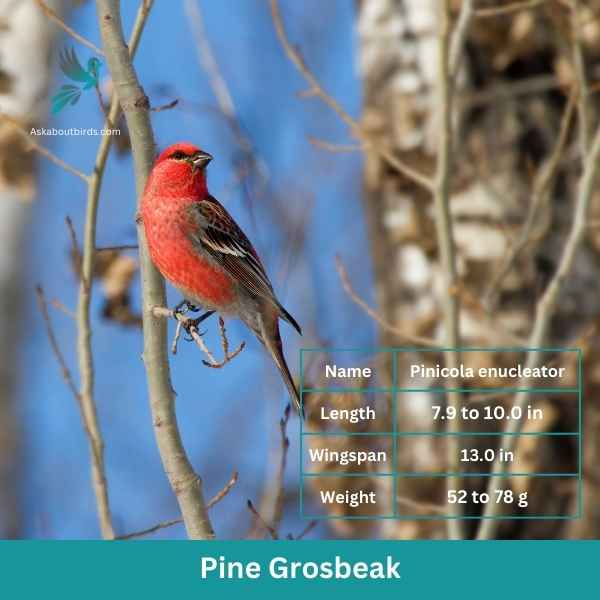
| Feature | Measurement |
|---|---|
| Scientific Name | Pinicola enucleator |
| Length | 7.9 to 10.0 in |
| Wingspan | 13.0 in |
| Weight | 52 to 78 g |
The Pine Grosbeak is a striking bird native to the northern regions of North America, often found in coniferous forests. Both males and females have a plump and robust body with a large beak adapted for eating seeds. The male Pine Grosbeak displays a vibrant reddish-pink plumage, while the female has a more subdued grayish-brown coloration.
These birds are typically seen in small flocks, foraging for food in trees and on the ground. They have a preference for seeds, particularly those from various conifer species. The Pine Grosbeak uses its strong bill to crack open the cones of tall trees and extract the seeds, but they also consume berries and small fruits when available.
Red Crossbill

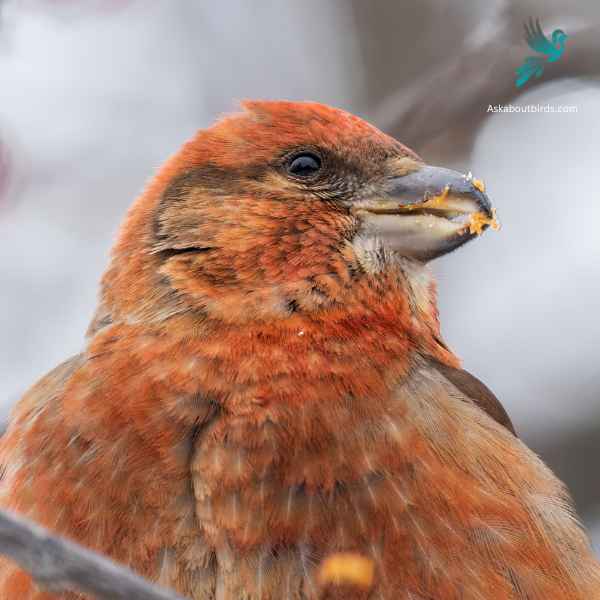
| Feature | Measurement |
|---|---|
| Scientific Name | Loxia curvirostra |
| Length | 5.5–7.5 in |
| Wingspan | 9.8–10.6 in |
| Weight | 0.9–1.4 oz |
The Red Crossbill is a distinctive finch known for its unusual bill, which has evolved to extract seeds from conifer cones.
Appearance: Males are typically bright red or orange, while females are greenish-yellow or olive. Both genders have the characteristic crossed bill, which they use to expertly extract seeds from tightly closed conifer cones.
Diet: Red Crossbills primarily feed on the seeds of coniferous trees, such as spruce, pine, and fir. Their specialized bills allow them to efficiently pry apart conifer cone scales to access the seeds.
Reproduction: Red Crossbills are somewhat nomadic and don’t adhere to a strict breeding schedule. Instead, they breed whenever and wherever food is abundant. Their nests are usually built on horizontal branches of conifer trees.
Purple Finch


| Feature | Measurement |
|---|---|
| Scientific Name | Haemorhous purpureus |
| Length | 4.7–6.3 in |
| Wingspan | 4.7–6.3 in |
| Weight | 0.6–1.1 oz |
The Purple Finch is a vibrant songbird often mistaken for its close relative, the House Finch, but it exhibits a different hue and patterns.
Appearance: Males are raspberry red on the head, throat, and breast, with streaky brown backs and wings. The intensity of the red can vary among individuals. Females are brown and streaked all over but might show a slight blush on the face. They lack the strong facial patterns seen in female House Finches.
Diet: Purple Finches primarily consume seeds, with a preference for sunflower seeds, dandelion seeds, and buds. They also eat insects and berries, especially during the breeding season.
Reproduction: These finches often nest in conifers or mixed woodlands. The nest, typically located on a horizontal branch, is made from twigs and grass, then lined with feathers.
Common Redpoll

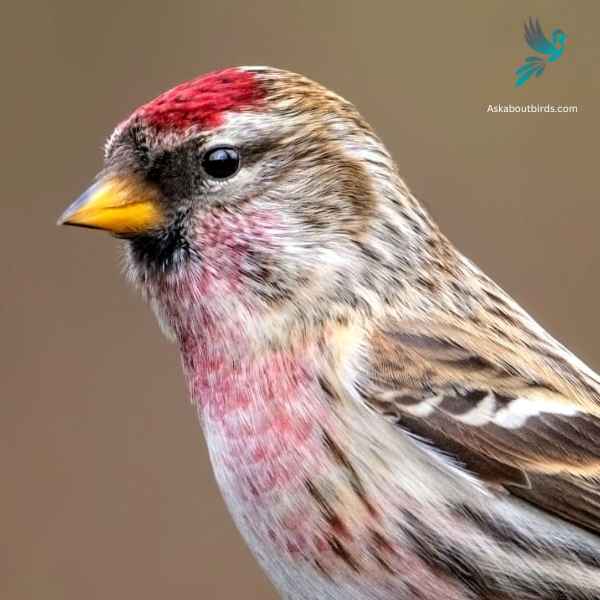
| Feature | Measurement |
|---|---|
| Scientific Name | Acanthis flammea |
| Length | 5.0-5.5 in |
| Wingspan | 7.5-8.5 in |
| Weight | 0.4-0.9 oz |
The Common Redpoll is a small songbird that is easily identifiable by its rosy-red forehead, black chin, and often fluttering flight pattern.
Appearance: Common Redpolls exhibit a distinctive rosy-red forehead patch and black chin. The males typically have a more extensive pink wash on their chest and face than females. The rest of their body is primarily streaked brown and white, with two white wing bars and a notched tail.
Diet: The diet of the Common Redpoll predominantly consists of seeds, particularly from birches and alders. They have a specialized throat pouch where they can temporarily store seeds, allowing them to consume them later in a more sheltered location.
Reproduction: Common Redpolls nest in shrubs or on the ground, using grasses, twigs, and feathers for construction. The female is responsible for the majority of the incubation and typically lays a clutch of 4 to 6 eggs. After the eggs hatch, both parents take part in feeding the young.
Where to Spot Wisconsin’s Red Birds
Wisconsin’s varied terrains have long been a haven for birdwatchers, offering some of the finest locales to spot a diverse range of avian species, especially the captivating red birds. Here are some standout locations:
- Horicon Marsh: Recognized as a Wetland of International Importance, it’s one of the best birdwatching spots in the Midwest. Home to more than 300 species, it’s especially vibrant during migration seasons.
- Chequamegon-Nicolet National Forest: Encompassing over a million acres, this northern forest is a haven for woodland birds, with its dense stands of pines, hardwoods, and crystal-clear lakes.
- Devil’s Lake State Park: Set in the Baraboo Range, the park’s unique geography attracts a variety of birds. The steep cliffs and deep blue lake provide habitats for both woodland and water birds.
- Crex Meadows Wildlife Area: Located in Grantsburg, this vast expanse of wetlands and prairies is a hotspot during the migration season, attracting thousands of waterfowl and grassland birds.
- Wisconsin Point: Situated on the westernmost tip of Lake Superior, it’s a crucial resting place for migrating birds. Its beaches, dunes, and forests offer a picturesque setting for birdwatching.
| State’s Red Birds | Top Spots for Red Birds |
|---|---|
| Minnesota’s Red birds | 1. Sax-Zim Bog 2. Itasca State Park 3. Tamarac National Wildlife Refuge |
| Iowa’s Red birds | 1. Neal Smith National Wildlife Refuge 2. Ledges State Park 3. Big Creek State Park |
| Michigan’s Red birds | 1. Sleeping Bear Dunes National Lakeshore 2. Seney National Wildlife Refuge 3. Tawas Point State Park |
| Illinois’s Red birds | 1. Starved Rock State Park 2. Cache River State Natural Area 3. Montrose Point Bird Sanctuary |
FAQs on Red Bird Species Found in Wisconsin
Why are black oil sunflower seeds favored by wild birds?
Black oil sunflower seeds are a top choice among wild birds, especially for species like the white winged crossbills and the painted bunting. These seeds, widely used in backyard feeders, attract a diverse range of birds due to their high nutritional content. Particularly in the northern and western states, bird enthusiasts have noted an influx of birds year-round when these seeds are available. Plus, their compatibility with various bird feeder types makes them ideal for birdwatching.
How can one identify the white winged crossbill?
White winged crossbills, predominantly seen in the northern and western states, are distinguishable by their unique tail feathers and vibrant red plumage in males. Their preference for conifer seeds, especially from pine cones, often places them high in the forest canopy. Notably, their name originates from their distinct beak shape, adapted to extract seeds. Birdwatchers looking to spot this species often stock their backyard feeders with black oil sunflower seeds, given the bird’s fondness for them.
What sets the painted bunting apart in Central and South America?
The painted bunting, with its striking vibrant red plumage and green wings, stands out prominently in the avian world of Central and South America. This bird, with its bright red feathers, often frequents forest edges, making it a visual treat against the forest canopy backdrop. Their distinct appearance combined with their unique songs makes them a sought-after sight for birdwatchers. Backyard feeders stocked with black oil sunflower seeds in the southern and eastern states might occasionally attract this accidental or rare species.
Are red bellied woodpeckers common in the eastern and southern states?
Red bellied woodpeckers, identified by their raspberry red head and pale bill, are indeed more common in the eastern and southern states. Their year-round presence is accentuated by their signature calls echoing through pine trees and forest edges. Bird identification for this species is relatively straightforward, given their distinct reddish hue and dark gray wings. While they predominantly feed on insects, during colder months, they might visit backyard feeders offering black oil sunflower seeds, fruit trees’ offerings, or pine cones.





